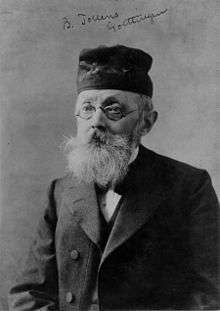Bernhard Tollens
Bernhard Christian Gottfried Tollens (30 July 1841 – 31 January 1918) was a German chemist.
Bernhard Tollens | |
|---|---|
 Bernhard Tollens | |
| Born | 30 July 1841 |
| Died | 31 January 1918 (aged 76) Göttingen, Germany |
| Alma mater | University of Göttingen |
| Scientific career | |
| Doctoral students | Emil Votoček |
Life and work
Tollens attended school at the Gelehrtenschule des Johanneums in Hamburg where he was influenced by his science teacher, Karl Möbius. After graduating in 1857, Tollens started an apprenticeship in pharmacy. He finished in 1862 and began studying chemistry in Göttingen in Wöhler's laboratory, then supervised by Friedrich Konrad Beilstein and Rudolph Fittig. In 1864, Tollens submitted his thesis and received his PhD without a defense. The latter was possible through the intercession of Wöhler so that Tollens could accept and begin an attractive job at a bronze factory. Tollens left the job after six months and joined the group of Emil Erlenmeyer at the University of Heidelberg for six months. He later worked with Charles-Adolphe Wurtz in Paris and, for 11 months, as chief of the chemical laboratory at the University of Coimbra in Portugal.[1]
Unable to resist the call of Wöhler, his former professor, Tollens returned to Göttingen in 1872 and there he remained in various positions until his death in 1918. It was during this final time in Göttingen that he started his work on carbohydrates, which yielded structures of several sugars, the Tollens reagent, and most of his publications.
References
-
- Browne, C. A. (1941). "Bernhard Tollens (1841-1918) and Some American Students of his School of Agricultural Chemistry". Journal of Chemical Education. 19 (6): 253–259. Bibcode:1942JChEd..19..253B. doi:10.1021/ed019p253.
Further reading
- Wallach, Otto (1918). "Nekrolog : Bernhard Tollens". Berichte der deutschen chemischen Gesellschaft. 51 (2): 1539–1555. doi:10.1002/cber.19180510244.
- Browne, C. A. (1942). "Bernhard Tollens (1841-1918) and Some American Students of his School of Agricultural Chemistry". Journal of Chemical Education. 19 (6): 253–259. Bibcode:1942JChEd..19..253B. doi:10.1021/ed019p253.